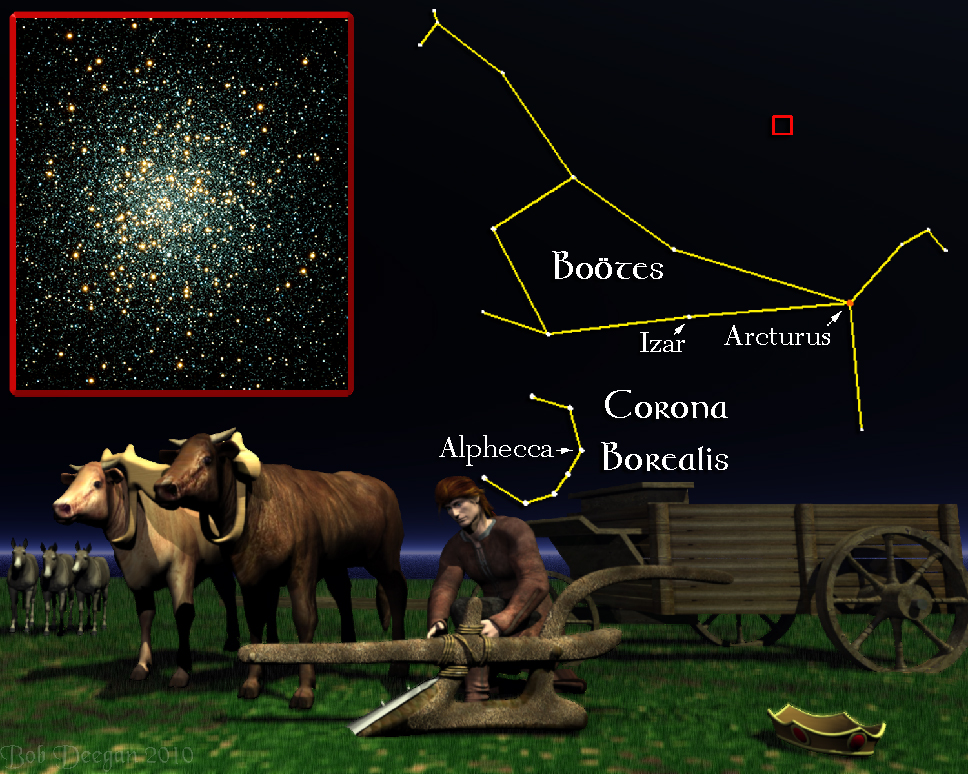
For the week including March 19, 2010

HERDSMAN AND CROWN
If you look to the east after 9pm, you will see a group of stars ranging over a wide area of sky that looks like a large kite with a bright orange star near its tail. This is the constellation of Boötes (boh-OH-teez), The Herdsman, who patiently herds his oxen around the North Star every day. Stories about this constellation have been around for a long time. In the Odyssey which dates back over three thousand years, Homer calls this constellation the Wagoner. Another tale says that these stars commemorate the inventor of the plow and European myths say that the hand of Boötes stretches toward the plow-shaped stars of the Big Dipper.
The brilliant star shining in Boötes has received much more attention than the rest of the constellation. The star is Arcturus, the fourth brightest star visible in the evening. Arcturus, means “The One Who Guards the Bears”, an ancient name derived from the way Arcturus circles the northern constellations of the Greater and Lesser Bears (Ursa Major and Ursa Minor). Still later, the word arctic would describe the northlands encircled by this star. At thirty-four light years away, Arcturus is more than twenty times larger than our Sun and, if it were as close to us, would shine over 110 times brighter. Thirty-four light years isn’t very far away compared to most stars, so Arcturus looks so bright mostly because it’s so close. The Earth even receives some of the heat generated by this star. If you haven’t noticed much of a change in your heating bills since Arcturus appeared in the sky, it’s understandable. The heat we get has been compared to the amount a person might feel from a candle that sat about five miles away. Near Arcturus is Izar, a beautiful double star composed of topaz and blue companions. If you like double stars, there’s also a nice set of three that are the topmost stars in our illustration. They have the unusual names of Asellus Primus, Secundus and Tertius, the first, second and third Donkeys.
An easy object to find is the magnificent globular cluster M3, shown in the National Optical Astronomy Observatory photograph at upper left in our illustration. Globular clusters are spherically shaped groups of old stars that can contain anywhere from tens of thousands to several million stars. In some of these clusters’ cores, the stars are packed in so tightly they’re closer together than the planets in our solar system. M3 coalesced inside an enormous cloud of hydrogen as our Milky Way galaxy was forming. These clusters are located beyond the plane of our galaxy, well past any of the individual stars we see at night.
When you’re out exploring Boötes, look for one of my favorite little constellations, Corona Borealis, the Northern Crown. Corona Borealis is a compact crescent of stars that looks like a smile set on its side. The brightest of its stars, Alphecca, is set like a diadem near the center of the crown. Known since the days of Ptolemy, the rising of the Northern Crown confirms that spring has arrived.
Unless otherwise indicated, all content of this web site is the copyright of Robert Deegan and all rights are reserved.
For more information, or to comment, please contact: Bob@NightSkies.org